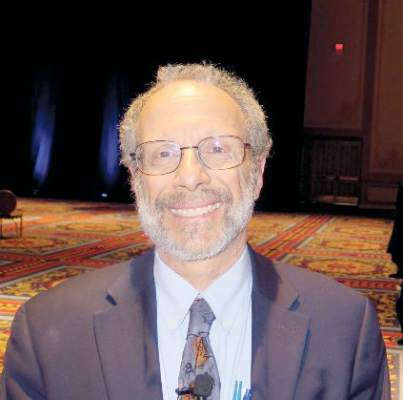EXPERT ANALYSIS AT NPA 2018
LAS VEGAS (FRONTLINE MEDICAL NEWS) – Michael J. Gitlin, MD, was 6 months removed from his psychiatry residency in 1980 when, for the first time, a patient he cared for took his own life.
He was a chronically depressed young man receiving medication and psychotherapy, and had one prior suicide attempt, Dr. Gitlin , now professor of psychiatry and biobehavioral sciences at the University of California, Los Angeles, recalled at an annual psychopharmacology update held by the Nevada Psychiatric Association. “One day he came in and intimated that he was going to kill himself, but not in the near future so as to not upset his parents. I scheduled another visit with him in 2 days and told him, ‘If you’re really having trouble, I’ll put you in the hospital.’ ”
The man never showed for that planned visit. Dr. Gitlin telephoned acquaintances and eventually the police, and through the window of his apartment, they observed his dead body. “That was my first experience, where I began to think, ‘what does this do to us as psychiatrists, and how do we deal with it?’ ”
According to Dr. Gitlin, fewer than 25 papers in the medical literature address the topic of how to cope when a patient takes his or her own life. He considers it ironic, because about 42,000 people in the United States die from suicide each year. “Of that 42,000, a reasonable percentage have seen a health professional, and a little lower percentage a mental health professional, within a number of weeks before the suicide happened,” he said. “Probably 10,000 psychiatrists per year will have this experience.”
The best available literature on the topic shows that about one in six psychiatrists reports having more than five patient suicides during an entire career. “There are two issues here,” Dr. Gitlin said. “One is, because it’s such an infrequent event, nobody has a big enough series to write about. The other issue is, because it’s so infrequent, nobody learns particularly well how to cope with it. You can’t become an oncologist if you’re really phobic and overwhelmed every time a patient dies. But it happens infrequently enough in psychiatry that nobody really masters a way of coping.”
Younger age and lesser clinical experience are most powerful predictors of distress. In fact, over a 3-year training period, about one-third of psychiatry residents will have a patient commit suicide. “Is that because our young colleagues just don’t know what to do and they’re not as thoughtful and as wise, and have as good a judgment as we have and do?” Dr. Gitlin asked. “Of course not. It’s because we give the most ill patients to the people with the least experience. Residents treat much more psychiatrically ill patients, who therefore have a higher risk of suicide.”
Responses are wide-ranging and are similar to other meaningful losses in life. One study found that about 38% of psychiatrists experience levels of distress in the first few weeks after a patient suicide, which is comparable to that of a clinical population ( Am J Psychiatry. 2004;161:1442-6 ). “If you take those same people and follow them out, that level drops rather precipitously, from 38% to 5% or 10%,” Dr. Gitlin said. “That means that it feels like an acute stress reaction. By 6 months, the effect has faded significantly. One-third of psychiatrists will say that when a patient commits suicide, it affects their personal life to some significant degree, and 15% say they thought about retirement. But if you push them on it, only about 3% think about it seriously.”
Typically, the first stage of response to a patient suicide is denial, which might include an overwhelming feeling of shock or a sense of depersonalization and de-realization, “where there’s a numbness that kind of shuts you down, because the effect is too overwhelming,” he said. Reflecting on the patient who took his own life as Dr. Gitlin was beginning his career, he said, “I didn’t have denial with this young man; I had depersonalization, where for the next few weeks I was at UCLA hanging out with psychiatrists and I felt like there was some film between me and everybody else.
“And nobody else in this department of board-certified psychiatrists noticed a damn thing. It was all internal, and it was a striking thing. It’s the only time in my life I’ve ever felt that.”
Other reactions include “core responses” of grief, guilt, shame/fear of blame, anger, and relief. “This is not in a variant sequence and not everybody has every one of these feelings,” he emphasized. “If you’ve been working with this person for any extended period of time, you can get attached to them, so you grieve the loss of a person,” he said.
A loss of hope also can occur. “We all imagine that we’re going to help people; a suicide shoves that notion aside,” Dr. Gitlin said. “But in many ways the biggest grief is what I call loss of influence to make a change. I suspect this is truer for younger psychiatrists than for older ones. Early on in our career we all have this feeling that if we do right, if we take good care of the patients, if we’re kind to them and respect boundaries, and we return phone calls, that good things are going to happen. Then you work very hard taking care of a patient as best you can, and they kill themselves on your watch. That changes the equation.”
Another common response when a patient takes his or her own life is a sense of shame. “Think about the cardiologist who loses a patient from heart disease,” said Dr. Gitlin, who also directs the UCLA Mood Disorders Clinic. “Do they feel bad? I assume so. Do they feel a sense of shame? I suspect not. Why do we feel the shame and embarrassment, and they don’t? Even the most hard-core psychopharmacologists among us really don’t believe that it’s just the technical aspects of treatment that make our patients better. It’s us; it’s our relationship with them. That makes the failure of a patient who dies not a clinical failure, but a personal failure. To me, that is the core reason why suicide feels different from an oncologist losing a patient to a disorder that has a known fatality rate.”
A fear of blame, or of being sued, can materialize. So can anger, which can raise complicated questions. For example, are you angry at the patient for committing suicide? Is the family angry? And who are they angry at? Are they angry at you? Are they angry at the hospital? “If it’s in a broader system, let’s say a hospital system, there’s a hierarchy,” Dr. Gitlin said. “Staff could be angry at the ward chief, who could be angry at the attending physician. It can roll downhill. In a complex environment the possibility of projected blame can become a big deal.”
In his opinion, the most important coping technique is to decrease isolation. “In every major religion in the world, when there’s a loss, you rally around the person,” he said. “The rituals of the rallying around differ across cultures and religions, but the rallying around is universal. As humans, we know that it’s much more painful to sit alone with your pain than with the support of family members, friends, loved ones, and community. Find the right person [to confide in]. Not everybody you know will be the right person.”
After the death of a patient from suicide, Dr. Gitlin makes it a point to offer to meet with loved ones. “If you do meet with them, be prepared,” he cautioned. “You don’t know whether the families are a family of interjectors or projectors. Are they going to come in and say, ‘Doctor, thank you so much for doing your best for helping my relative,’ or are they going to come in and say to you, ‘You jerk; my kid died under your care.’ Be prepared for anything that happens in that room.” He also recommends asking the family’s permission to attend the patient’s funeral.
Another helpful coping strategy is to conduct a “psychological autopsy” with colleagues. “Ask what could have been done differently [in the case], not to blame, but to learn,” Dr. Gitlin said. “I have been to some psychological autopsies where it was just ‘Who can be blamed?’ and it was always the youngest person on the totem pole. If the institution can’t get it right psychologically, they shouldn’t do it. That’s more destructive than not doing it at all.”
Maintaining professional boundaries with patients also can help you cope. “We don’t want to put so much into our work with our patients that if it goes bad, we get overwhelmingly devastated,” he said. “Finding that middle ground between blurring boundaries and being too detached is something that every mental health professional should do. Distinguishing between clinical and personal failure is critical. I made a decision some time ago that I want to work with people with prominent psychiatric difficulties. We have some difficult patients, but the philosophical and cognitive relief that I give myself when bad things happen is that I say to myself, ‘I chose to work with sick people. Some of them will die of their illness. I’ll save some, but I can’t save them all.’ There’s a natural mortality rate with mood disorders that is related to suicide, just like 5%-10% of anorexics die from anorexia nervosa. That’s the natural mortality rate of the disease.”
Dr. Gitlin ended his presentation by underscoring the importance of establishing support systems in your workplace or teaching institution. For example, he gives lectures to second-year psychiatry residents at UCLA on the topic of psychiatrist reactions to patient suicide, “because I’m giving them the lecture I wish somebody had given me when I was their age. I and others at UCLA make ourselves available to the residents if and when this happens to them.
“Within our field, most training programs do not deal with this issue as forthrightly as they should. It is our job as the grown-ups in the room to make sure that we do it better. We should be talking with the residents early on about it. Every training institution should have a system set up that when it happens, senior residents help junior residents and faculty is available if a resident is really having trouble dealing with it. Some residencies do this well, and others don’t do it at all.”
Dr. Gitlin reported having no financial disclosures.





